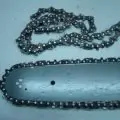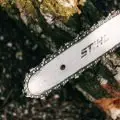We use chainsaws to simplify our outdoor duties. It is considerably quicker and easier to complete tasks like chopping firewood, removing small or large trees, or trimming low-hanging tree limbs. Our outdoor lives would be significantly more difficult and clearly different if we didn’t have chainsaws.
However, chainsaws are only useful when they are in good working order. When you are about to make the first cut with a chainsaw that started and seemed to be running well, you may realize that the chain is not moving when the throttle is engaged. The chain may not turn for several reasons.
In this article, we’ll discuss why a chainsaw runs but the chain won’t turn, providing all the possible causes and solutions to each so you can get back to your projects ASAP!
Table of Contents

Why Is My Chainsaw Chain Not Turning
- Engaged chain brake
- Damaged chain
- Worn-out guide bar
- Malfunctioning chain oiler
- Worn-out clutch
Anybody can find a chainsaw chain won’t spin freely situation to be very frustrating. However, even for a beginner chainsaw user, this is typically a relatively simple issue to fix with minimal knowledge. I’ll go over each of these circumstances in detail below, along with solutions.
Engaged Chain Brake
You might be wondering what a chain brake on a chainsaw is if you read this and find your chainsaw blade not spinning. The chain brake is merely a security feature added to chainsaws to protect the user. If necessary precautions are not taken, chainsaws can be fatal.
When starting the chainsaw, moving to a new work area, or when near other persons, the chainsaw operator should purposefully use the chain brakes. Although there are additional circumstances in which a chain brake may be required, these are the most frequent ones.
The chain brake on a chainsaw can be dangerous and annoying if the user has not received adequate training on how to activate and disengage the break. An operator may believe the saw is broken when, in fact, the brake only has to be in the released position if they are unaware of the chain brake’s existence and how to disengage it.
How to Fix a Chain Brake Engaged
The main chainsaw handle will be directly in front of the chain brake. Simply pushing forward on the handle activates the chain brake. The handle must be pulled back to release the chain brake.
Damaged Chain
When the chainsaw is functioning properly, the chain is what actually cuts. The chainsaw chain, however, is susceptible to damage to the point where the chainsaw is unable to be operated. Without removing the chain from the guide bar, this form of damage cannot be seen.
How to Fix a Damaged Chain
Examine the pointed bottom of the chain after it has been removed. The term “chain drag” refers to this section of the chain. In the guide bar slot rail, the chain drag slides. The chain will become stuck in this section of the chain damaged because it cannot slide around the guide bar in a suitable manner.
Not all chain drags will result in damage. Most likely, only a few of the chain drags will sustain damage. The damage will typically be modest but noticeable and take the form of a burr (rough place). This damage is typically brought on by running the chain too loosely or by a chain sprocket that is worn out. The chain will need to be replaced with a new chain if it is damaged.
Worn-Out Guide Bar
The chainsaw’s guide bar, which is a lengthy bar, holds the chain in place. A guide bar can obstruct a chain from spinning properly in one of three ways.
1. A worn guide bar sprocket would be the first possible cause. The guide bar sprocket’s job is to reduce friction as much as possible while the chain revolves around the bar’s tip.
2. A pinch in the guide bar slot rail is the second way a guide bar can stop a chain from spinning. The chain won’t be able to move through the rail slot if the slot rail is obstructed by a piece of wood.
3. A guide bar’s bend is the third and last way it can stop a chain from twisting.
How to Fix a Worn-Out Guide Bar
1. The chain won’t be able to turn if this sprocket cannot, and vice versa. By taking the saw’s bar and chain off, you can verify this. Remove the chain from the guide bar after removing the bar and chain from the saw. The sprocket on the end of the bar should now be visible. When the sprocket won’t turn, the guide bar is locked and needs to be replaced.
The bar may be split at the sprocket if the chain can turn but the sprocket is still unable to do so. If this is the case, it is possible that the chain may become jammed between the bar’s sprocket’s edge and its side, necessitating replacement.
2. You may verify this by taking the saw’s guide bar off. The pinch will typically be noticeable right away. If the bar is pinched, replacing the bar is preferable to attempting to loosen the pinched area.
3. It will be clear that a new guide bar is required if this is the case.
Malfunctioning Oiler
A chainsaw’s oiler’s job is to lubricate the joint between the guide bar and the chainsaw chain. Overheating will occur in the chain and guide bar if the oiler is not operating properly. The guide bar and chain may be irreparably damaged by overheating, and the chain itself may stop turning as a result.
The oil pump may seize through normal wear and tear or become clogged with debris, which can result in oiler failure. It’s also possible that the oiler itself is operating normally and the chain and guide bar not getting oil from it.
This is most often brought on by a blocked oil port on the chainsaw or guide bar. The oil will not be able to travel from the chain saw to the guide bar if one or both of these openings is blocked.
How to Fix a Malfunctioning Oiler
You will almost certainly need to take your saw to the dealer for repairs if the oil pump seizes. If the holes are blocked, the chainsaw and guide bar’s oil ports can simply be cleaned out using compressed air. This will fix your oiling issue by enabling the oil to flow properly to the chain and guide bar.
Worn-Out Clutch
The clutch on a gas chainsaw is responsible for transferring power from the engine to the sprocket, which in turn causes the chain to turn and cut wood.
The clutch shoes can wear out over time and lose their ability to transfer the saw’s power without slipping, which can cause the chain to slow down or stop altogether. If the sprocket turns, but the chain isn’t, the clutch is worn-out.
How to Fix a Worn-Out Clutch
If the clutch on your saw is worn, a repair dealer should probably replace it. The dealer should be able to finish the repair in 30 minutes or less of work because it is not a particularly complicated one.
Here’s a YouTube demonstration on replacing the clutch drum on an Echo chainsaw, with the steps detailed below!
Replacing a Worn-Out Clutch Assembly
Total Time: 15 minutes
Cool Engine
First, allow the chainsaw engine to cool.
Remove Cover
Unclip and remove the cover before removing the wire and boot from the spark plug to stop the chainsaw from accidentally starting.
Remove Clutch Cover
Unscrew the nuts securing the clutch housing and pull the side cover off.
Remove Bar
Remove the chainsaw bar and chain, and confirm the chain brake is in the off position.
Remove Clutch Drum Assembly
Use a flat head screwdriver to remove the C-clip on the clutch. Then pull off the washer, clutch drum, and bearing.
Install New Clutch Drum Assembly
Slide the new bearing onto the drive shaft, followed by the clutch drum and washer. Secure the assembly with the c-clip.
Re-attach Guide Bar and Chain
Make sure the chain is on the guide bar and loop the chain onto the clutch sprockets as you align the bar groove on the mounting bolts.
Adjust Tension
The chain tensioner will need to be inserted into the hole on the chain bar. Adjust the chain tensioning screw counter-clockwise to properly align the tensioner. With the clutch cover in place, hand tighten the nuts. Lift the bar and rotate the adjustment screw clockwise until there is no slack in the chain. But ensure the chain isn’t too tight.
Final Assembly
Tighten the nuts. Attach the wire and boot to the spark plug. Realign the top cover and secure it with the clips.
Tools:
- Flat head screwdriver
- Clutch drum assembly (clutch drum, washer, bearing)
More chainsaw troubleshooting:
- How to Port a Chainsaw
- Are Chainsaw Bars Interchangeable
- How to Unflood a Chainsaw and Start It Once Flooded
FAQs (Frequently Asked Questions)
Why is my chainsaw chain not turning?
Chain brake engagement, worn guide bars, broken chains, inoperable chain oilers, or worn-out clutch are all potential causes of a chainsaw chain that won’t turn.
Should chainsaw chain spin freely?
Yes, a chainsaw chain should spin freely for you to be able to conduct your tasks with optimum performance. If your chainsaw chain is not spinning freely, it indicates you have an issue with the chain itself, a worn-out clutch, a worn-out guide bar, a malfunctioning chain oiler, or simply a brake engagement.
How do you get a chainsaw chain unstuck?
To unstuck a chainsaw chain, you may need to replace the chain if it is damaged, repair or replace the clutch, replace the guide bar, clean the chain oiler port holes, or disengage the chain brake.



